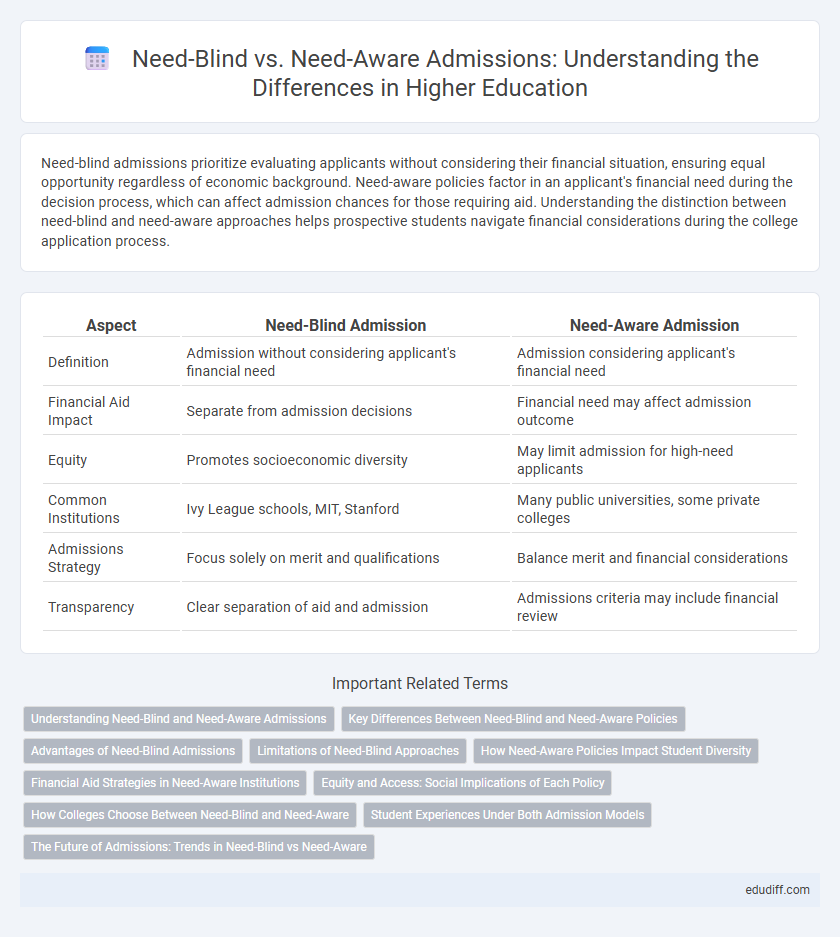Need-blind admissions prioritize evaluating applicants without considering their financial situation, ensuring equal opportunity regardless of economic background. Need-aware policies factor in an applicant's financial need during the decision process, which can affect admission chances for those requiring aid. Understanding the distinction between need-blind and need-aware approaches helps prospective students navigate financial considerations during the college application process.
Table of Comparison
| Aspect | Need-Blind Admission | Need-Aware Admission |
|---|---|---|
| Definition | Admission without considering applicant's financial need | Admission considering applicant's financial need |
| Financial Aid Impact | Separate from admission decisions | Financial need may affect admission outcome |
| Equity | Promotes socioeconomic diversity | May limit admission for high-need applicants |
| Common Institutions | Ivy League schools, MIT, Stanford | Many public universities, some private colleges |
| Admissions Strategy | Focus solely on merit and qualifications | Balance merit and financial considerations |
| Transparency | Clear separation of aid and admission | Admissions criteria may include financial review |
Understanding Need-Blind and Need-Aware Admissions
Need-blind admissions evaluate applicants without considering their financial situation, promoting equitable access by focusing solely on academic merit and personal achievements. Need-aware admissions include financial need as a factor in the decision-making process, which can impact the likelihood of admission for students requiring financial aid. Understanding the distinction between these policies helps applicants navigate college admissions strategies and financial aid planning effectively.
Key Differences Between Need-Blind and Need-Aware Policies
Need-blind admission policies evaluate applicants without considering their financial need, ensuring equal consideration regardless of economic background, whereas need-aware policies factor in an applicant's ability to pay during the decision process. Need-blind institutions prioritize diversity and inclusion by admitting solely on merit, while need-aware schools may limit financial aid resources and admit more full-pay students to balance budget constraints. The key difference lies in how financial need influences admission decisions, impacting access and socioeconomic diversity within the student body.
Advantages of Need-Blind Admissions
Need-blind admissions prioritize academic merit by evaluating applicants without regard to their financial situation, resulting in a more equitable selection process focused solely on qualifications. This approach increases diversity by admitting talented students from various economic backgrounds who might otherwise be overlooked. Institutions practicing need-blind policies often enhance their reputation for fairness and inclusivity, attracting a wider pool of high-achieving candidates.
Limitations of Need-Blind Approaches
Need-blind admission policies often overlook the significant financial constraints faced by underrepresented students, limiting access despite academic merit. These approaches can inadvertently favor applicants from wealthier backgrounds who do not require financial aid, thus perpetuating socioeconomic disparities. The inability to account for institutional financial resources during the process constrains effective diversity and inclusion efforts.
How Need-Aware Policies Impact Student Diversity
Need-aware policies in college admissions can reduce socioeconomic diversity by limiting financial aid for lower-income applicants, often resulting in a higher enrollment of wealthier students. Research shows that institutions adopting need-aware practices experience a decline in underrepresented minorities and first-generation college students. These policies prioritize institutional financial stability over inclusivity, impacting the overall demographic makeup and access to higher education opportunities.
Financial Aid Strategies in Need-Aware Institutions
Need-aware institutions tailor financial aid packages based on an applicant's demonstrated financial need, balancing budget constraints with enrollment goals to optimize resource allocation. These schools employ strategic aid distribution to attract a diverse student body while maintaining fiscal sustainability, often prioritizing candidates who fit institutional priorities beyond just merit. Understanding the interplay between need-aware policies and financial aid strategies helps applicants navigate scholarship opportunities and enhances institutional recruitment efficacy.
Equity and Access: Social Implications of Each Policy
Need-blind admissions promote equity by admitting students without considering financial need, enhancing access for diverse socio-economic backgrounds but often requiring substantial institutional resources. Need-aware policies can allocate limited aid more strategically, potentially increasing financial sustainability while risking reduced access for low-income applicants. The social implications of each approach influence the diversity and inclusivity of educational environments, impacting broader efforts toward equal opportunity.
How Colleges Choose Between Need-Blind and Need-Aware
Colleges choose between need-blind and need-aware admissions based on their financial aid budgets and institutional priorities, balancing access with sustainability. Need-blind policies admit students without considering financial need, often requiring substantial endowments to support comprehensive aid packages. Need-aware colleges factor in applicants' financial need to manage limited resources, aiming to maintain economic diversity while ensuring fiscal responsibility.
Student Experiences Under Both Admission Models
Students admitted through need-blind policies often report feeling more focused on their academic potential rather than financial background, fostering a sense of equal opportunity and inclusion. Need-aware admissions can lead to increased anxiety about financial aid, influencing students' perception of campus culture and support systems. Data from multiple universities indicate that under need-blind models, retention rates and student satisfaction tend to improve due to reduced financial stress and enhanced diversity.
The Future of Admissions: Trends in Need-Blind vs Need-Aware
Higher education admissions are increasingly balancing the principles of need-blind and need-aware policies to address equity and financial sustainability. Institutions adopting need-blind admissions prioritize evaluating applicants without regard to financial need, promoting diversity and inclusion, while need-aware strategies allow colleges to consider financial need to optimize resource allocation and yield management. Emerging trends indicate a hybrid approach where colleges integrate data-driven financial aid models and socioeconomic demographics to enhance fairness and institutional affordability in the future admissions landscape.
Need-Blind vs Need-Aware Infographic

 edudiff.com
edudiff.com